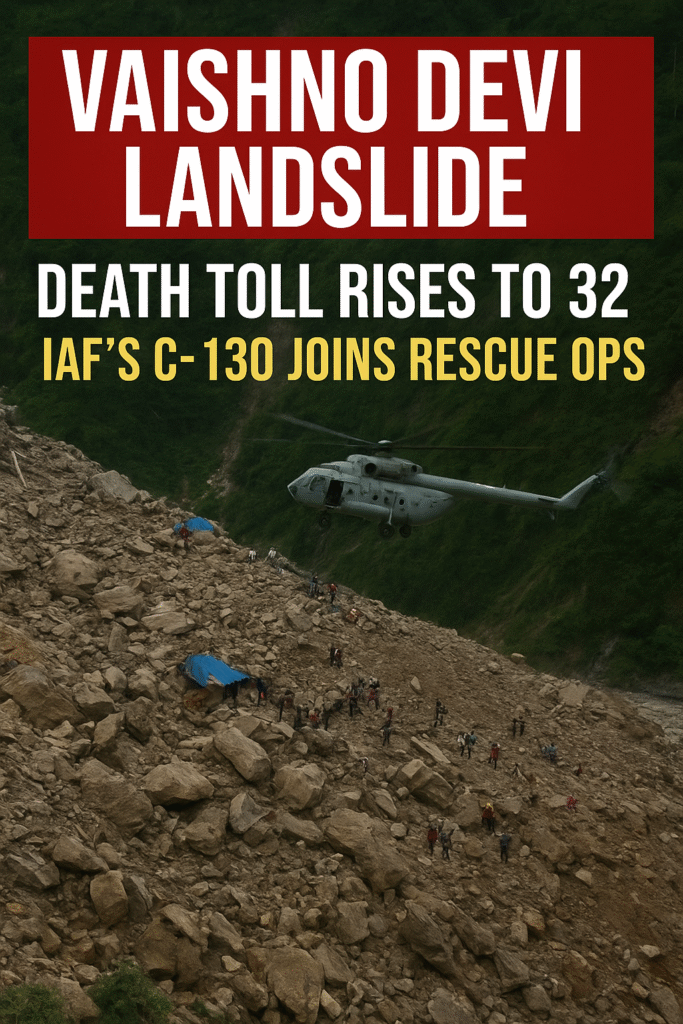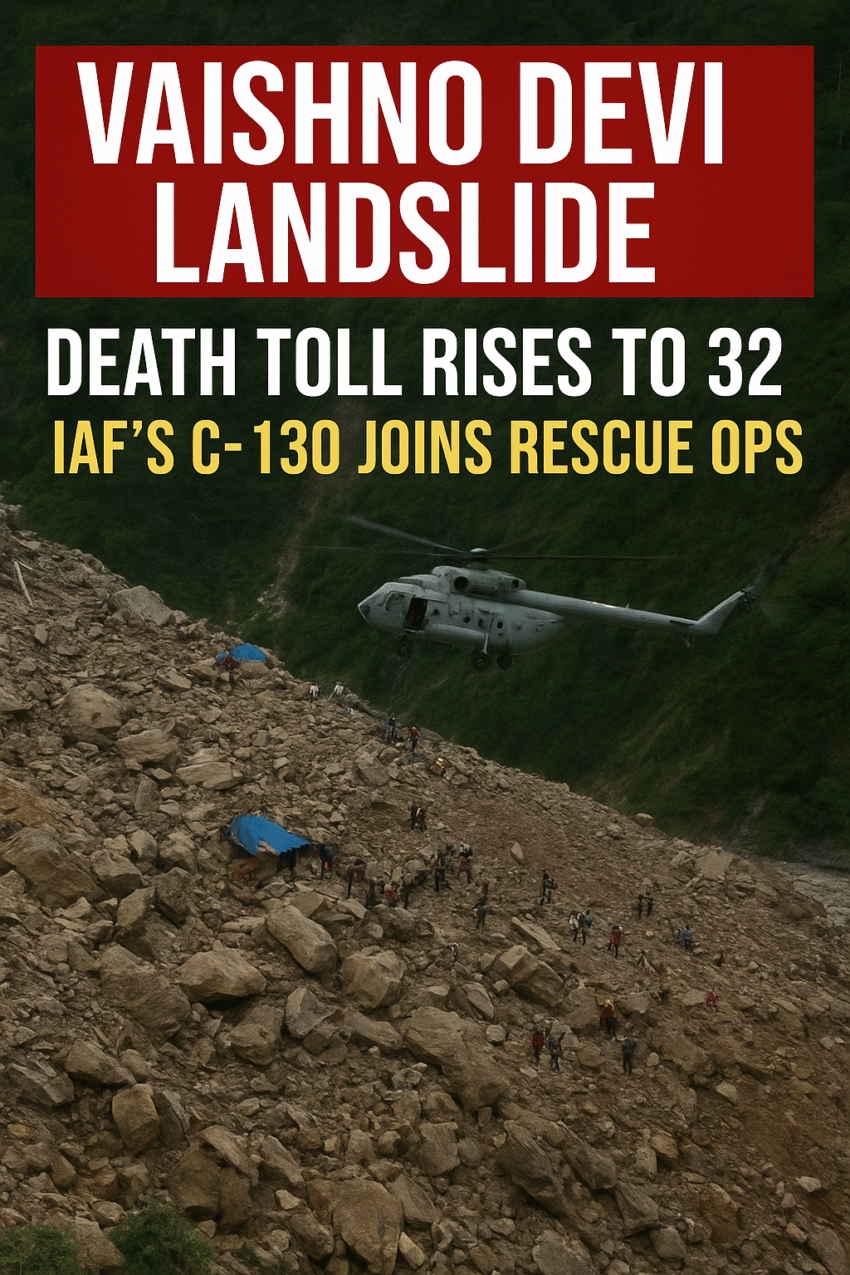
Vaishno Devi Landslide: Pilgrimage Turns Into Tragedy
The sacred pilgrimage route to the Vaishno Devi shrine in Jammu and Kashmir has turned into a scene of devastation following a massive Vaishno Devi landslide in the Reasi district. The death toll has tragically climbed to 32, while dozens remain trapped under boulders and debris. Rescue teams are working around the clock, battling treacherous terrain and unpredictable weather to save lives.
The incident has triggered a nationwide outpouring of grief and raised urgent questions about the safety of pilgrimage routes in the Himalayan region, where landslides are a recurring threat.
IAF’s C-130 Joins Rescue Mission
In a decisive move, the Indian Air Force (IAF) deployed its powerful C-130 transport aircraft to support ongoing rescue operations. The aircraft has been airlifting specialized equipment, heavy machinery, and rescue personnel to the disaster-hit region.
Helicopters have also been deployed for aerial reconnaissance, identifying trapped survivors and assisting in evacuations. Officials say the use of the C-130 has dramatically improved the pace of operations, particularly given the blocked road access to the shrine.
Multi-Agency Response: Army, NDRF, SDRF
Rescue operations are being spearheaded by a joint team comprising the Indian Army, National Disaster Response Force (NDRF), and State Disaster Response Force (SDRF). Together, they have managed to rescue more than 40 stranded pilgrims, while dozens more are still missing.
Heavy machinery is being used to clear boulders, while sniffer dogs and ground-penetrating equipment are deployed to detect survivors under rubble. Temporary medical camps have also been established near the site to provide first aid and emergency care to the injured.
Pilgrimage Suspended Amid Safety Concerns
Authorities have suspended the Vaishno Devi Yatra until further notice, urging devotees to postpone their travel. With monsoon-triggered landslides becoming frequent in the Himalayan belt, the Shrine Board is prioritizing safety over religious obligations.
This suspension has disrupted the journey for thousands of pilgrims, many of whom had traveled from across India. However, officials have reassured devotees that rescue and restoration are the top priorities before any reopening of the route.
Eyewitness Accounts: “Thunderous Noise, Then Darkness”
Survivors of the Vaishno Devi landslide have shared chilling accounts of the disaster. One pilgrim, who narrowly escaped, described hearing a “thunderous noise” moments before huge boulders rolled down the hillside, engulfing everything in their path.
Others recalled scenes of chaos, with devotees trapped and families desperately searching for loved ones. Many were stranded for hours in darkness before the first rescue teams managed to reach the site.
These accounts highlight both the unpredictability of natural disasters and the urgent need for better safety measures on high-risk routes.
Govt and Leaders React to the Vaishno Devi Landslide
Jammu and Kashmir Lieutenant Governor Manoj Sinha expressed deep grief over the tragedy, announcing compensation packages for the families of the deceased and free treatment for the injured.
Home Minister Amit Shah has been monitoring the situation, directing central agencies to provide maximum support. The Prime Minister’s Office also conveyed condolences, emphasizing that the nation stands with the victims of the Vaishno Devi landslide.
Relief camps have been set up for stranded devotees, and helplines have been activated to assist families searching for missing relatives.
Weather Challenges Hindering Rescue Efforts
Despite the best efforts of agencies, operations continue to face severe challenges. The mountainous terrain, combined with persistent rainfall, has made excavation and debris clearance extremely difficult. Authorities have also warned of the possibility of fresh landslides, forcing teams to operate cautiously.
Experts caution that the Vaishno Devi landslide may not be an isolated event, as fragile Himalayan slopes are highly vulnerable during monsoon months.
Environmental Concerns and Infrastructure Woes
The tragedy has reignited debates around unchecked construction, deforestation, and slope instability in the Himalayan region. Experts say that inadequate slope management and unplanned development near pilgrimage routes amplify the risk of disasters like the Vaishno Devi landslide.
Environmentalists have called for stricter geological surveys, better drainage systems, and the introduction of early-warning technology to prevent such large-scale loss of life in the future.
A Nation Mourns Yet Again
The Vaishno Devi landslide has left the entire country shaken. As images of grieving families and tireless rescue workers emerge, the disaster serves as a painful reminder of the vulnerability of mountain communities and pilgrims alike.
While the death toll continues to rise, the courage of rescue personnel offers a glimmer of hope. The resilience of survivors, coupled with the swift deployment of IAF resources, showcases India’s ability to mobilize during national crises.
For now, however, the focus remains on one goal: saving as many lives as possible.
Conclusion: A Tragedy That Demands Action
The Vaishno Devi landslide is not just a natural calamity—it is a wake-up call. As pilgrims continue to risk their lives in fragile terrain, authorities must strengthen disaster preparedness, enhance infrastructure resilience, and implement stricter monitoring of vulnerable zones.
The nation will remember this tragedy not only for its heavy loss of lives but also for the lessons it teaches. Ensuring the safety of spiritual journeys must now be treated as a national priority.

